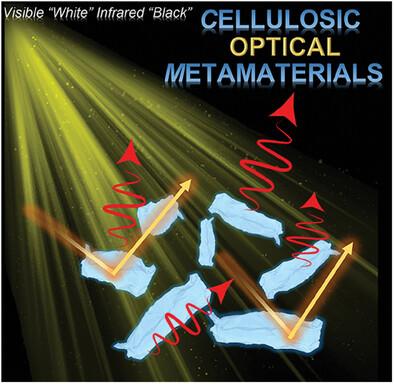当前位置:
X-MOL 学术
›
Adv. Funct. Mater.
›
论文详情
Our official English website, www.x-mol.net, welcomes your feedback! (Note: you will need to create a separate account there.)
Cellulose Metamaterials with Hetero‐Profiled Topology via Structure Rearrangement During Ball Milling for Daytime Radiative Cooling
Advanced Functional Materials ( IF 18.5 ) Pub Date : 2024-06-28 , DOI: 10.1002/adfm.202405903 Chenyang Cai 1 , Xiaodan Wu 1 , Fulin Cheng 1 , Chunxiang Ding 1 , Zechang Wei 2 , Xuan Wang 3 , Yu Fu 1
Advanced Functional Materials ( IF 18.5 ) Pub Date : 2024-06-28 , DOI: 10.1002/adfm.202405903 Chenyang Cai 1 , Xiaodan Wu 1 , Fulin Cheng 1 , Chunxiang Ding 1 , Zechang Wei 2 , Xuan Wang 3 , Yu Fu 1
Affiliation

|
Passive radiative cooling is a zero‐energy consumption approach, which can dissipate heat to outer space by emitting infrared radiation through the transparency window. Traditional cooling materials, such as photonic films, metafabrics, and polymer foams, still suffer from complex preparation processes and high costs. In this work, it is reported that natural cellulose can be converted into a “green” optical metamaterial by rational structure reconfiguration at the micro/nano level via scalable ball milling technology for efficient daytime radiative cooling. Specifically, fine‐tuning the shearing kinetics in the mechanochemistry process, cellulosic optical metamaterial (COM) with ≈98% solar reflectivity and ≈0.97 infrared emissivity has been successfully achieved, which can break through the theoretical value of photonic crystals as well as the conventional synthetic optical materials. The COMSOL simulation reveals that the excellent optical properties of the cellulose metamaterial are explained by the “confined scattering” effect caused by the rearranged heterostructure at the micro/nano level. Outdoor tests demonstrat that the COM‐based coating exhibits a daytime radiative cooling efficiency of 5.7 °C in hot Nanjing. Meanwhile, the COM can be produced into different scattering materials via spray coating, freeze casting, and solution casting technology. This study will facilitate the development of scalable and sustainable optical metamaterials for mitigating energy consumption.
中文翻译:

通过球磨过程中的结构重排实现白天辐射冷却的纤维素超材料
被动辐射冷却是一种零能耗的方法,它可以通过透明窗发射红外辐射将热量散发到外太空。传统的冷却材料,如光子薄膜、超织物和聚合物泡沫,仍然存在制备工艺复杂和成本高昂的问题。据报道,在这项工作中,天然纤维素可以通过可扩展的球磨技术在微/纳米水平上进行合理的结构重构,转化为“绿色”光学超材料,以实现高效的白天辐射冷却。具体来说,通过微调机械化学过程中的剪切动力学,成功实现了太阳光反射率约98%、红外发射率约0.97的纤维素光学超材料(COM),突破了光子晶体的理论值以及传统材料的限制。合成光学材料。 COMSOL模拟表明,纤维素超材料的优异光学性能是由微/纳米水平上异质结构重排引起的“限域散射”效应解释的。室外测试表明,COM基涂层在炎热的南京白天的辐射冷却效率为5.7°C。同时,COM可以通过喷涂、冷冻浇铸、溶液浇铸技术生产成不同的散射材料。这项研究将促进可扩展且可持续的光学超材料的开发,以减少能源消耗。
更新日期:2024-06-28
中文翻译:

通过球磨过程中的结构重排实现白天辐射冷却的纤维素超材料
被动辐射冷却是一种零能耗的方法,它可以通过透明窗发射红外辐射将热量散发到外太空。传统的冷却材料,如光子薄膜、超织物和聚合物泡沫,仍然存在制备工艺复杂和成本高昂的问题。据报道,在这项工作中,天然纤维素可以通过可扩展的球磨技术在微/纳米水平上进行合理的结构重构,转化为“绿色”光学超材料,以实现高效的白天辐射冷却。具体来说,通过微调机械化学过程中的剪切动力学,成功实现了太阳光反射率约98%、红外发射率约0.97的纤维素光学超材料(COM),突破了光子晶体的理论值以及传统材料的限制。合成光学材料。 COMSOL模拟表明,纤维素超材料的优异光学性能是由微/纳米水平上异质结构重排引起的“限域散射”效应解释的。室外测试表明,COM基涂层在炎热的南京白天的辐射冷却效率为5.7°C。同时,COM可以通过喷涂、冷冻浇铸、溶液浇铸技术生产成不同的散射材料。这项研究将促进可扩展且可持续的光学超材料的开发,以减少能源消耗。











































 京公网安备 11010802027423号
京公网安备 11010802027423号